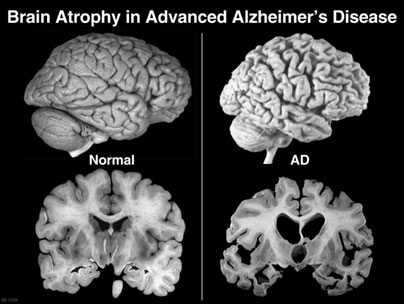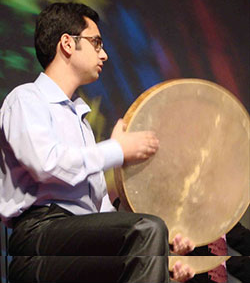A Personal Quest to Beat Alzheimer’s
 Mohammadali Tabatabaei is on a mission. As a PhD student in the Department of Chemistry, Mohammadali research is bridging the disciplines of physical chemistry, engineering, and biology to better understand Alzheimer's disease. He is painfully aware of the slow, inexorable progress of the disease in his grandmother. "It has come to a point where she does not recognize her own children anymore," he notes.
Mohammadali Tabatabaei is on a mission. As a PhD student in the Department of Chemistry, Mohammadali research is bridging the disciplines of physical chemistry, engineering, and biology to better understand Alzheimer's disease. He is painfully aware of the slow, inexorable progress of the disease in his grandmother. "It has come to a point where she does not recognize her own children anymore," he notes.
Mohammadali's grandmother is one of the thirty-six million people worldwide living with Alzheimer's. The World Health Organization predicts this number to triple by 2050. Roughly seven percent of Canadians over the age of sixty-five suffered with this memory-robbing scourge with annual healthcare costs of $5.5 billion. This number is projected to exceed three-quarters of a million by 2031.
When Mohammadali learned that his application for a PhD position at Western had been accepted, he jumped at the opportunity to pursue research in neuro-degenerative diseases and eventually Alzheimer's. "This has been my first chance to truly help my grandmother" he says. For the past thirty years, scientists have been trying to fill in the gaps in our understanding about the disease. Mohammadali, as a researcher in physical chemistry is attempting to make the biologist's job a tad easier.
In an Alzheimer's patient's brain, abnormal protein fragments called amyloid-beta clump together, forming plaques between neurons. Plaques prevent neurons from communicating with one another and its eventual progress throughout the whole brain manifests in the loss of memory, speech and motor patterns and eventual death. "If we can isolate individual neurons and their connections, obtain high-resolution images of them, and are able to see the distribution of amyloid-beta on them, we can understand Alzheimer's a bit better", notes Mohammadali.
Neuronal connections are seemingly random assortments of tangles, akin to a collection of wet hairballs, making it impossible to examine them in an organized fashion. To this end, he has built a particular kind of glass-slide on which he can direct the growth of neuronal connections through specific channels that he has etched onto the glass-slide. Mohammadali describes the process as "taking a three-dimensional world of knots and jumbles and making it a two-dimensional world of order." Onto this two-dimensional world, he applies a sensitive measuring device that can discern chemical signatures at an atomic level enabling him to see the distribution of amyloid-beta at a super-high resolution.
Mohammadali has had to combine knowledge of physical chemistry, engineering and biology in order to understand how beta-amyloid affects neurons. Whilst a PhD student of physical and analytical chemistry in François Lagugné-Labarthet's laboratory, he frequently collaborates with Dr. Stephen S. G. Ferguson, a biologist in the Molecular Brain Research Group and professor of physiology and pharmacology at the Schulich School of Medicine and Dentistry. "I had no background in biology or engineering when I joined Western but the learning experience has been more than amazing", he observes.
 Mohammadali is no stranger to improvisation, collaboration and learning on the go. An avid player of the traditional Iranian percussion instrument Daf, he has given a number of concerts as a solo musician and as a part of a traditional Iranian music ensemble called 'Vasl _e _yar' based in Tehran. "Being a musician, especially as part of a group, has really given me an insight into the collaborative and improvisational nature of any creative endeavor." Here in London, he and his friends have music-night get-togethers where he plays the Daf accompanied by guitar and violins. "Playing the Daf helps me unwind and relax after a busy day at the lab", Mohammadali mentions.
Mohammadali is no stranger to improvisation, collaboration and learning on the go. An avid player of the traditional Iranian percussion instrument Daf, he has given a number of concerts as a solo musician and as a part of a traditional Iranian music ensemble called 'Vasl _e _yar' based in Tehran. "Being a musician, especially as part of a group, has really given me an insight into the collaborative and improvisational nature of any creative endeavor." Here in London, he and his friends have music-night get-togethers where he plays the Daf accompanied by guitar and violins. "Playing the Daf helps me unwind and relax after a busy day at the lab", Mohammadali mentions.
During his undergraduate studies, Mohammadali came across an online video on neuroscience and its effects on social life. He remembers being amazed "to learn about how everyday activities and music can affect your brain at a fundamental level, but also, how the brain releases chemicals that can impact and modify one's behavior." Years later, Mohammadali's passion for music and biology research remains strong.
There will come a time in the near future when Mohammadali's grandmother may be unable to recognize the musician behind the music and when he will only be able to soothe his grandmother's heart with the song of the Daf. He continues to dig for deeper understanding in the world of Alzheimer’s research with the hope that one day, doctors and biologists will use the fruits of his labor to better understand and tackle this pervasive illness.

